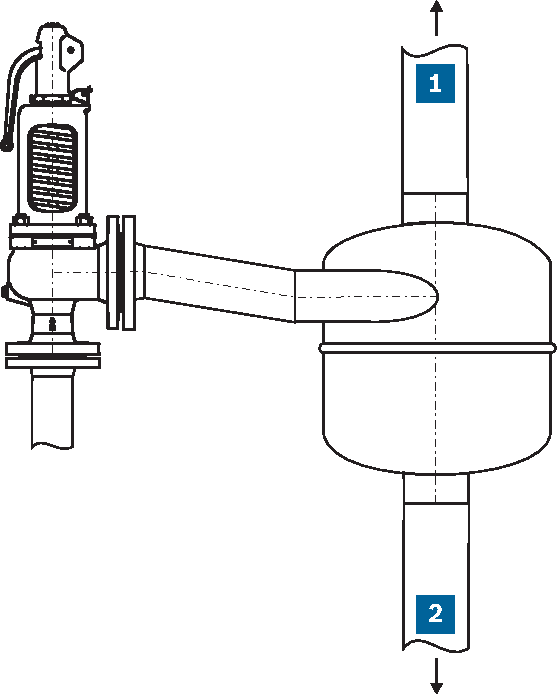Get in touch!
Safety valve blow-off pipe
Blow-off pipe in the steam area
The following criteria must be observed when installing the safety valve blow-off pipe for steam:
- The blow-off pipe must be dimensioned so that an inherent back-pressure amounting to 10% of the excess pressure is not exceeded when discharging.
- Up to a pipework length of 10m and a maximum of 5 elbows: 2 DN larger than the nominal outlet diameter of the safety valve.
- If the pipework is longer or a greater number of elbows are used, a detailed calculation of the pressure loss in the pipework is recommended.
- A sloping section of pipe (≥0.5%) must initially be mounted at the valve outlet to create a low point in the blow-off pipe from which liquid can drain off via a device which cannot be shut off.
- If there is a drainage hole in the seat of the safety valve, additional drainage should be provided.
- The blow-off pipe must be isolated from other pipework (e.g. air vent lines, expansion lines, safety valve blow-off pipes) and protected against freezing.
- Blocking of the drainage by dirt or foreign matter must be avoided.
- Harmless discharge of condensate must be ensured.
- The blow-off pipe must be installed and fastened so that the safety valve is not exposed to shear, bending or torsional forces (e.g. by using supports, spring-loaded pipe hangers). The reaction forces when discharging must be taken into consideration.
- The blow-off pipe must terminate harmlessly.
The functional capability of the safety valve and blow-off pipe is verified on site by the approved notified body during acceptance testing of the steam boiler, and normally at full combustion output during real operation.
Technical information: requirements for the boiler installation room

Drainage of blow-off pipe and safety valve
|
|
Drainage of safety valve blow-off pipe |
|
|
Seat drainage of safety valve |
Blow-off pipe in the liquid area
The following criteria must be observed when installing the safety valve blow-off pipe for liquids:
- The blow-off pipe of a safety valve which is connected to a water chamber must be equipped with an expansion and water separation chamber.
- The system on the discharge side of the safety valve must be dimensioned so that an inherent back-pressure amounting to 10% of the excess pressure is not exceeded when discharging.
- The section of pipe between the safety blow-off valve and the expansion and water separation chamber must be installed with a slope (≥0.5%).
- If there is a drainage hole in the seat of the safety valve, additional drainage should be provided.
- In doing so, the drain line must be installed with a slope and without constriction.
- Blocking of the drainage by dirt or foreign matter must be avoided.
- The condensate that accumulates in the expansion and water separation chamber must be safely removed and cooled.
- The section of pipe between the safety blow-off valve and expansion and water separation chamber must be installed and fastened so it is not exposed to shear, bending or torsional forces (e.g. by using supports, spring-loaded pipe hangers). The reaction forces when discharging must be taken into consideration.
- High temperatures, flow speeds and flow noise occur when discharging. The blow-off pipe at the expansion and water separation chamber must therefore discharge to the atmosphere in such a way that it cannot pose any danger.
- The blow-off pipe at the expansion and water separation chamber must be isolated from other pipework (e.g. air vent lines, expansion lines, safety valve blow-off pipes) and protected against freezing.

Safety valve with expansion and water separation chamber
|
|
Blow-off pipe harmlessly through roof |
|
|
Drainage line for harmless discharge and cooling |

